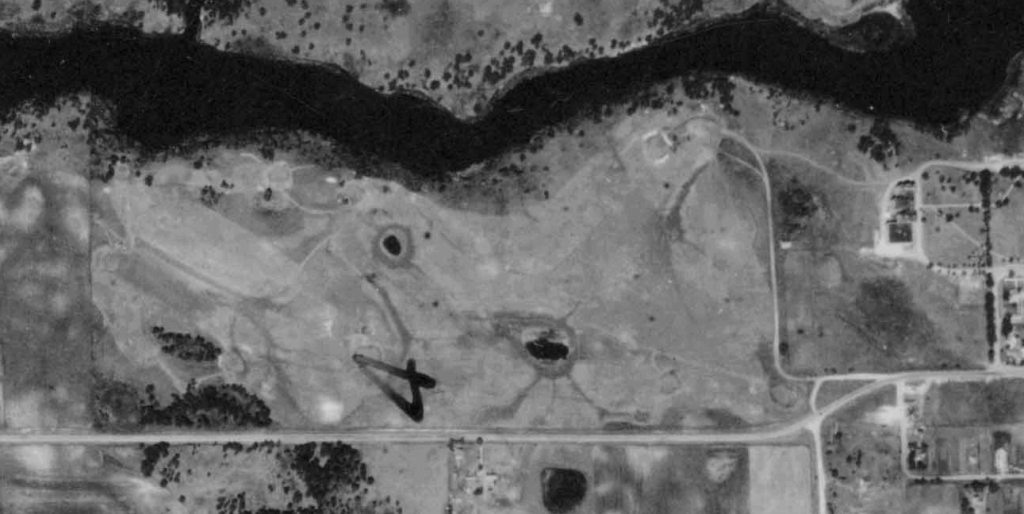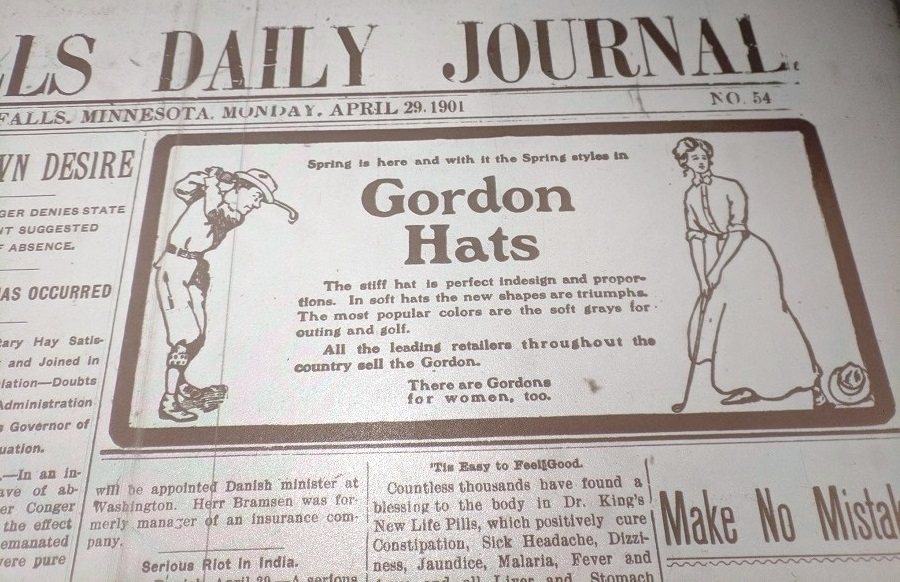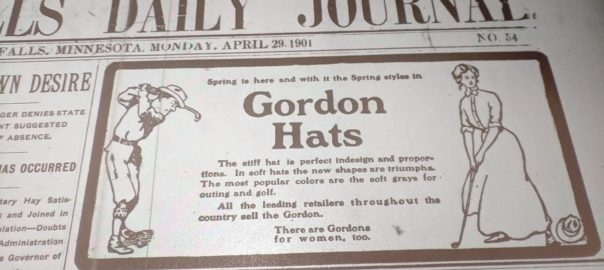Golf has had many wonderful and skilled caddies. Among the pantheon of the all-time greats are the likes of Angelo Argea (Jack Nicklaus), Herman Mitchell (Lee Trevino), Fanny Sunnesson (Nick Faldo) and Steve Williams (Tiger Woods).
Before that, there was Robert Overgaard.
Hold on. I never said Overgaard belonged among those legendary loopers. I just said, before that …
Robert Overgaard caddied as a youth at one of Fergus Falls’ two known lost golf courses — Riverside Links (Minnesota lost course No. 204) — and today, at age 89, would have to be one of the very few remaining Fergus Falls citizens who has firsthand memories of the course, which was situated along the south bank of the Otter Tail River just less than a mile southwest of downtown and had a nice run for a lost course, 1922 to 1940.
Overgaard’s memories of Riverside include a fellow named Tomhave who was the club’s best player despite using only irons and who thought Overgaard was a darn good caddie.
“I caddied for Tomhave, and he used me as sort of a rabbit’s foot, “Overgaard said by phone from Fergus Falls. “I had a butch, and the first time I ever caddied for him he had a real good score, and so after that, he wanted me to caddie. He’d rub my head and say, ‘Hey, come over here, I got a tough shot here’ and he’d rub my butch haircut.”
Overgaard laughed, the distant past still worth a good chuckle.
With the help of Overgaard’s memory and a smattering of old newspaper stories, an attempt at reconstructing the Riverside course can be made (the Otter Tail County Historical Society has more newspaper stories, for anyone interested in a deeper dive):
“Fergus Golf Course Ready,” proclaimed a headline in the April 29, 1922, edition of the Fergus Falls Journal. “Golf is something new in Fergus Falls,” the story began (not true; more on that to come). The nine-hole course covered 65 acres of farmland west of Park Region College, which later would become Hillcrest Lutheran Academy. “It is decidedly rolling (Overgaard pointed out that the terrain is much flatter today), giving players all the uphill and downhill that anyone could want.
“The river banks on the course afford a wonderful view of the city and a view of the Pisgah Dam and the lake above the green.”
Kenneth Fairbairn was placed in charge of the course, which to its significant credit featured grass greens. I say significant, because many 1920s-era courses in Minnesota’s smaller towns had sand greens, which were both cheaper and inferior to grass greens. But Fergus Falls had a population of 7,581 in 1920 and a well-established group of businessmen and professionals who could make a grass-greens golf course financially viable. Three doctors – H.A. Anderson, W.L. Peterson and H.J. Laffitte — were either officers or on the board of directors.
Riverside’s business structure was unusual. “It is probably the only golf course in the state that is not operated by a golf club,” the Minneapolis Tribune reported on May 13, 1928. “The Riverside Links, Inc., is a corporation of local citizens interested in golf and aiming to stimulate interest in golf, but it operates as a public golf corporation and not a club. It has leased the 65 acre course for a period of 20 years. … It relies on the sale of playing privileges entirely for its revenue.”
Overgaard’s recollection is that the Riverside plot was owned by Elmer Adams, a senator, editor and owner of much land in Fergus Falls, and the suggestion is that Adams leased the land to the golf corporation.
Overgaard did not remember the golf course’s entire routing but said the clubhouse lay near a grove of Russian olive trees just south of the river, he estimated 200 to 300 yards west of the westernmost building on the current Hillcrest Lutheran campus. “The site of the clubhouse is relatively intact,” he said.
Incidentally, the Hillcrest Lutheran Academy Comets and their football-playing brethren in the Little Eight Conference heap indignity upon the former Riverside grounds each autumn by clomping up and down the school’s football-stadium turf. Overgaard said Riverside’s first fairway would have lain right about where Westside Drive is, with the football stadium grounds perhaps at the edge of the fairway or just into the rough. (Don’t sweat it, Comets. March on.)
The first hole, Overgaard said, finished just north of Alcott Avenue, which today is farther south than it was in the 1920s and ’30s. Alcott was the course’s southern border. The course then proceeded west and north, to within perhaps 100 yards of the Pisgah Dam, and then returned home to the east. A 1939 aerial photo indicates a ninth hole alongside the Otter Tail River, probably a long dogleg, and Overgaard remembered that hooked shots could reach a watery grave.

Overgaard caddied during the Riverside course’s latter years. “It was quite nicely kept up,” he said. “The golf course was in many ways (supported by) the efforts of the businessmen to get golf established in town. It was a civic effort and got a lot of people in town interested in the game. It was only nine holes and was boxed in. … When it was gaining some momentum in the town, it became apparent they had to move.”
A site 2.8 miles southeast of downtown became the next home to golf in Fergus Falls. In 1941, Pebble Lake Golf Course opened along the southwestern shore of Pebble Lake. Its 18-hole layout was designed by probably Minnesota’s highest-profile golf course architect at the time, Paul Coates, whose design credits also include Keller in Maplewood, Stillwater Country Club and Pine Beach West at Madden’s in East Gull Lake.
PREQUEL
Riverside was not Fergus Falls’ first lost golf course, not by a long shot. That distinction belongs to a layout that preceded Riverside by more than two decades and remains largely a mystery.
The Fergus Falls Journal announced the arrival of organized golf in town on May 2, 1901. “A number of golf players have been out nearly every evening, and the game promises to be a very popular one during the coming summer,” the newspaper reported.
On May 6, the Minneapolis Journal chimed in. “Golf at Fergus Falls,” read a small headline. “The local golf club, which has just been organized, has laid out its links … and the game promises to be a very popular one this summer. A dozen enthusiasts have been practicing industriously during the past week and a large number have ordered outfits and signified their intent of joining the club.”
A more formal report came by way of the Fergus Falls Weekly. A May 23, 1901, meeting was called at the First National Bank for the purpose of “improvement of the greens.” On May 25, the Weekly reported that the Fergus Golf Club (lost course No. 205) had been organized the day before. “The game has awakened great interest here and starts out with twenty-five charter members.”
Those charter members included:
— Robert Hannah, club president, who likely knew his cleeks from his spoons as a native Scot. He was born in Ayrshire County, Scotland, in 1860, the same year the first Open championship was played at Prestwick, less than five miles from Ayrshire. Just up the road from Prestwick are two other famed golf clubs, Royal Troon and Kilmarnock. Hannah was a director of Fergus Falls’ First National Bank and is the namesake of Robert Hannah Recreational Area, alongside the Otter Tail River and just a couple of hundred yards east of the former Riverside Links grounds.
— Dr. J.G. Vigen, who as a native Norwegian perhaps didn’t own the golfing pedigree of Hannah but who certainly held stature in Fergus Falls.
Vigen and Hannah later would become charter members at the Riverside course.
Those are the known properties of Fergus Golf Club. Unfortunately, much is unknown. My guess is that the club lasted only through the 1901 season, as I could not find any references to it in searching Fergus Falls newspapers of 1902, ’03 or ’05. In any event, Fergus holds standing in Minnesota golf history. According to my research and records, it was among the first 15 golf courses built in Minnesota and among the first three built west of St. Cloud, rivaled only by Ada Golf Club (1900) and Marshall Golf Club (also 1901).
Also unknown was the Fergus Club’s course location — and there are apparent contradictions here. The Minneapolis Journal reported that the club “has laid out its links in the southwestern part of the city.” The Fergus Falls Daily Journal reported, “The links are in the vicinity of the Jefferson school building,” which was decidedly not near the southwestern part of the city but instead was more northeast, near Mount Faith and Springen avenues. The most concrete reference, however, lends credence to the southwestern notion. “The tennis court at the corner of Vernon and Union Avenues is a thing of the past,” Wheelock’s Weekly of Fergus Falls reported on May 9, 1901. “Golf promises to supplant tennis almost entirely in this neighborhood.” The intersection of Vernon and Union lies near the current southwestern corner of downtown Fergus Falls and a quarter-mile east of Robert Hannah Recreational Area.

Latest posts by Joe Bissen (see all)
- Another lost routing: Hilltop, Columbia Heights - June 19, 2024
- Two lost routes: First, Antlers Park - June 17, 2024
- Tree trouble and townball: Naeseth Country Club, Wanamingo - May 6, 2024
